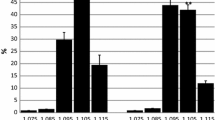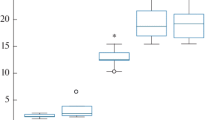Abstract
The interrelationship between purine nucleotide exchange and the antioxidant system in blood plasma and erythrocytes with respect to age, as well as the contribution of key enzymes of purine decomposition in the formation of derivatives of reactive oxygen metabolites, were studied. Fifty conditionally healthy individuals aged 40–79 years were examined. An age-related increase in all indicators of the blood plasma prooxidant system was found. In blood plasma, the statistically significant correlation of the studied parameters and age of the examined individuals, as well as the relationship between glutathione peroxidase and adenosine deaminase/xanthine oxidase, adenosine deaminase and xanthine oxidase were observed. A significant increase in the content of products of protein oxidative modification was found in plasma and erythrocytes during aging. A decrease in the activity of key antioxidant enzymes, superoxide dismutase, and glutathione peroxidase with age was observed in blood plasma and erythrocytes. The data obtained are indicative of an imbalance in the antioxidant system in blood plasma and erythrocytes, with age contributing to the development of pathological states as a result of increased oxidative stress, which is greatly manifested in aging.
Similar content being viewed by others
References
Bakurova, O.M., Popovich, O.Yu., Mironova, K.O., et al., Changes in activity of adenosine aminazine at lifted oncologic risk and carcinomas with different localization, Nauk. Visn. Uzhgorod. Univ., Ser. Med., 2011, no. 3(42), pp. 19–23.
Borzenko, B.G., Bakurova, E.M., Melozertsev, A.M., et al., Possible use of biochemical analysis for formation of the groups with high oncologic risk, Novoutvorennya Nauk.-Prakt. Zh., 2007, no. 2, pp. 60–66.
Vladimirov, Yu.A., Free radical in biological systems, Soros. Obraz. Zh., 2000, no. 4, pp. 71–78.
Kiselik, I.O., Lutsik, M.D., and Shevchenko, L.Yu., Peculiarities of determination of nitrates and nitrites in peripheral blood of patients with virus hepatitis associated with different etiology jaundice syndrome, Lab. Diagn., 2001, no. 3, pp. 43–45.
Kol’tover, V.K., Free radical theory of aging: historical review, Usp. Gerontol., 2000, no. 4, pp. 33–40.
Kul’chits’kii, O.K., A system of nitrogen oxide and age, Bukov. Med. Visn., 2005, no. 9(2), pp. 143–144.
Lakomaya, Yu.A., Titova, N.M., Kudryashov, A.M., and Kolosova, M.V., Aging of erythrocytes: status of glutathione antioxidant system, in Aktual’nye problemy meditsiny i biologii (Relevant Problems in Medicine and Biology), Moscow, 2003, no. 2, pp. 43–44.
Lishnevskaya, V.Yu. and Duzhak, G.V., Erythrocytes at aging, in Mater. IV Nats. kongr. gerontologiv i geriatriv Ukraini “Problemy stareniya i dolgoletiya” (Proc. IV Natl. Congr. of Gerontologists and Geriatrists “Problems of Aging and Longevity”), 2005, vol. 14,suppl., pp. 157–158.
Makarevich, O.P., Activity of the blood superoxidedismutase during acute diseases, Lab. Delo, 1983, no. 6, pp. 24–27.
Muravleva, L.E., Oxidative modification of proteins: problems and prospective studies, Fundam. Issled., 2010, no. 1, pp. 74–78.
Tolochko, Z.S. and Spiridonov, V.K., Oxidative modification of blood proteins in rats at wounding of capsaicin-sensitive nerves and changes of nitrogen oxide level, Ross. Fiziol. Zh., 2010, vol. 96, no. 1, pp. 77–84.
Chumakova, S.P., Shipulin, V.M., Urazova, O.I., et al., Antioxidative potential of erythrocytes and blood plasma in patients with heart ischemia associated with moderate and expressed hemolysis after surgeries with artificial blood circulation, Kradiol. Serdech.-Sosud. Khirurg., 2012, no. 6, pp. 95–99.
Shatova, O.P., Borzenko, B.G., Zinkovich, I.I., et al., Lactate dehydrogenase, adenosine desaminase, and thymidine phosphorylase activity of the blood and tissues at breast oncology, Ukr. Biokhim. Zh., 2009, vol. 81, no. 4, pp. 88–93.
Adams, B., Lowe, D.J., Smith, A.T., et al., Expression of Drosophila melanogaster xanthine dehydrogenase in Aspergillus nidulans and some properties of the recombinant enzyme, Biochem. J., 2002, pp. 223–229.
Cheng, M.L., Ho, H.Y., Wu, Y.H., and Chiu, D.T., Glucose-6-phosphate dehydrogenase-deficient cells show an increased propensity for oxidant-induced senescence, Free Radic. Biol. Med., 2004, vol. 36, no. 5, pp. 580–591.
Dalle-Donne, I., Protein carbonyl groups as biomarkers of oxidative stress, Clin. Chimica Acta, 2003, no. 329, pp. 23–38.
Drexler, H., Nitric oxide and coronary endothelial dysfunction in humans, Rev. Cardiovasc. Res., 1999, vol. 43, no. 3, pp. 572–579.
Gessi, S., Merighi, S., Stefanelli, A., et al., A(1) and A(3) adenosine receptors inhibit LPS-induced hypoxia-inducible factor-1 accumulation in murine astrocytes, Pharmacol. Res., 2013, vol. 76, pp. 157–170.
Gul, I., Gökbel, H., Belviranli, M., et al., Oxidative stress and antioxidant defense in plasma after repeated bouts of supramaximal exercise: the effect of coenzyme Q10, J. Sports Med. Phys. Fitness, 2011, vol. 51, no. 2, pp. 305–312.
Khan, N., Abrogation of potassium bromate-induced renal oxidative stress and subsequent cell proliferation response by soy isoflavones in Wistar rats, Toxicology, 2004, vol. 201, no. 1, pp. 173–184.
Lowry, O.H., Rosebrough, N.J., Farr, A.L., and Randall, R.J., Protein measurement with folin-phenol reagent, J. Biol. Chem., 1951, vol. 193, no. 21, pp. 265–275.
Merighi, S., Benini, A., Mirandola, P., et al., A3 adenosine receptors modulate hypoxia-inducible factor1alpha expression in human A375 melanoma cells, Neoplasia, 2005, vol. 7, no. 10, pp. 894–903.
Mikhailenko, V.M., Savtsova, Z.D., Glavin, O.A., et al., Effect of environmental nitric oxides on the antitumor resistance of rats, Exp. Oncol., 2005, vol. 27, no. 1, pp. 65–70.
Moin, V.M., Simple and specific method of measurement of glutathione peroxidase activity in the erythrocytes, Lab. Manuals, 1986, no. 12, pp. 724–727.
Ozturk, O. and Gumuslu, S., Age-related changes of antioxidant enzyme activities, glutathione status and lipid peroxidation in rat erythrocytes after heat stress, Life Sci., 2004, vol. 75, no. 13, pp. 1551–1565.
Shafreen, R.B., Pandian, S.K., Arun, S., et al., Protective effect of silymarin on erythrocyte haemolysate against benzo(a)pyrene and exogenous reactive oxygen species (H2O2) induced oxidative stress, Chemosphere, 2007, vol. 68, no. 8, pp. 1511–1518.
Tofovic, S.P., Jackson, E.K., and Rafikova, O., Adenosine deaminase-adenosine pathway in hemolysis-associated pulmonary hypertension, Med. Hypotheses, 2009, vol. 72, no. 6, pp. 713–719.
Zhou, F.L., Zhang, W., Wei, Y., et al., Involvement of oxidative stress in the relapse of acute myeloid leukemia, J. Biol. Chem., 2010, vol. 285, no. 20, pp. 15010–15015.
Author information
Authors and Affiliations
Corresponding author
Additional information
Original Russian Text © S.A. Zuikov, 2014, published in Uspekhi Gerontologii, 2014, Vol. 27, No. 3, pp. 463–467.
Rights and permissions
About this article
Cite this article
Zuikov, S.A. Study on nucleotide exchange and its interrelationship with prooxidant and antioxidant systems in humans of different ages. Adv Gerontol 5, 22–26 (2015). https://doi.org/10.1134/S2079057015010117
Received:
Published:
Issue Date:
DOI: https://doi.org/10.1134/S2079057015010117




